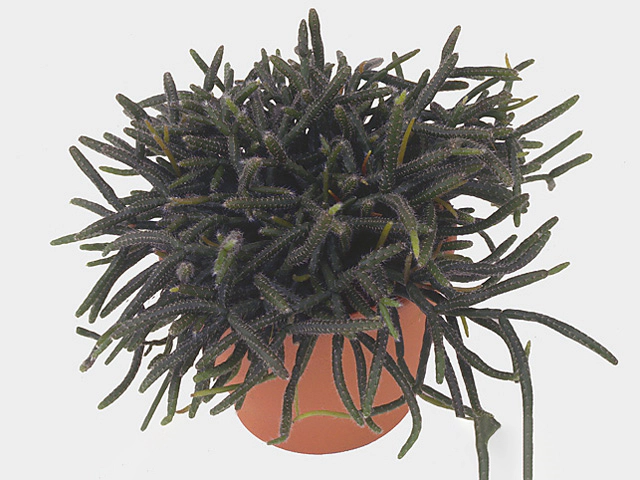Rhipsalis burchellii

Rhipsalis burchellii, commonly known as the Mistletoe Cactus, is a unique and fascinating plant that belongs to the cactus family. Unlike traditional cacti, this variety does not possess the typical spiky exterior. Instead, it features long, trailing stems that hang gracefully from its container, making it a popular choice for indoor gardens and hanging baskets.
Native to the rainforests of Brazil, Rhipsalis burchellii thrives in low light conditions and prefers a more humid environment compared to its desert-dwelling relatives. This makes it an excellent choice for those who struggle to keep other cacti alive in their homes. Despite its rainforest origins, this cactus is incredibly resilient and can adapt well to various conditions.
What sets the Mistletoe Cactus apart is its unique adaptation to its natural habitat. In the rainforest, it often grows as an epiphyte, attaching itself to trees and absorbing moisture and nutrients from the air and surroundings. This ability to cling onto trees gives it a mistletoe-like appearance, hence its common name.
The foliage of Rhipsalis burchellii is made up of cylindrical, green stems that can reach impressive lengths. These stems have tiny, hair-like thorns that allow the plant to climb and attach itself to supports in its native habitat. At the end of each stem, small white or yellow flowers may appear under the right conditions, adding a touch of delicate beauty to the cascading foliage.
Caring for Rhipsalis burchellii is relatively easy, making it an ideal plant for beginners. It prefers indirect sunlight, so placing it near a window with filtered light is ideal. Overexposure to direct sunlight may cause the plant to become sunburned and turn yellow. Like most cacti, it is drought-tolerant and does not require constant watering. Water only when the soil is dry to the touch, ensuring proper drainage to prevent root rot.
Another advantage of this Mistletoe Cactus is its ability to purify the air. Like other houseplants, Rhipsalis burchellii absorbs carbon dioxide and releases oxygen, making it beneficial for indoor air quality. Its trailing stems also make it an excellent addition to hanging baskets, where it can create a stunning visual display and bring a touch of nature to any space.
Propagation of the Mistletoe Cactus can be done through stem cuttings. Simply snip off a healthy portion of the stem and place it in a well-draining potting mix. Keep the soil slightly moist until new roots start to develop, which usually takes a few weeks. With proper care and attention, the cutting will grow into a new plant, allowing you to expand your collection or share it with fellow plant enthusiasts.
Overall, Rhipsalis burchellii, or the Mistletoe Cactus, is an intriguing and unique addition to any indoor garden. Its ability to thrive in low light conditions, its trailing stems, and ease of care make it a sought-after plant for beginners and experienced gardeners alike. Whether you choose to hang it in a basket or let it cascade down a shelf, this cactus is sure to add a touch of natural beauty to your space.
Market availability index by month:
| Jan. | Feb. | Mar. | Apr. | May | Jun. | Jul. | Aug. | Sep. | Oct. | Nov. | Dec. |
|---|---|---|---|---|---|---|---|---|---|---|---|
| 4 | 3 | 3 | 3 | 3 | 3 | 3 | 3 | 3 | 3 | 3 | 3 |